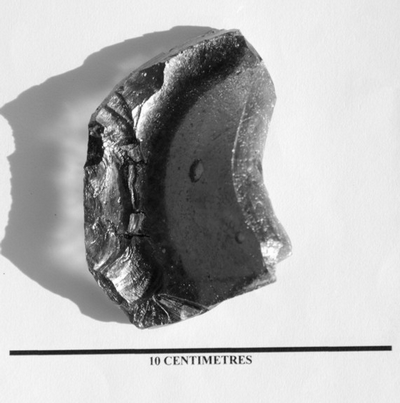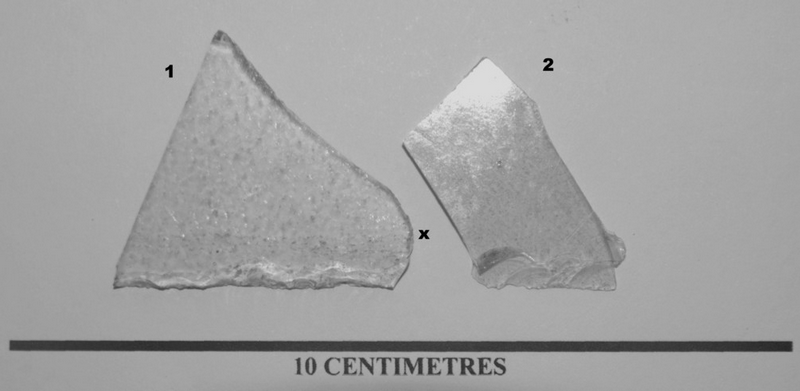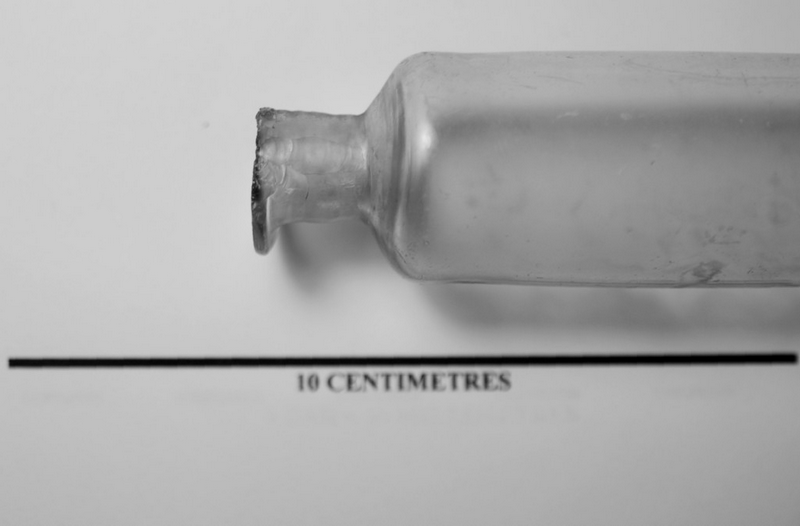 |
| Fig. 1. Bredon Hill, Elmley Castle, Worcestershire, VC37 SO94, 12 April 2009. Knapped fragment of 'black-glass onion' bottle circa AD1700 © Paul Whitehead |
Worcestershire Record No. 26 April 2009 pp. 28-30
P. F. Whitehead
This paper stems from the discovery on 12 April 2009 of a fragment of bottle glass (Fig. 1) in combe woodland on Bredon Hill in the parish of Elmley Castle. It is a basal fragment of a 'black glass' onion bottle, or sack bottle, dating from circa AD1700. The glass is 16mm thick and the base is characteristically 'kicked-up'.
 |
| Fig. 1. Bredon Hill, Elmley Castle, Worcestershire, VC37 SO94, 12 April 2009. Knapped fragment of 'black-glass onion' bottle circa AD1700 © Paul Whitehead |
Fig. 1 illustrates the straight cutting edge that has been applied to one side of the fragment, firstly by invasive percussive removals, and then evidently by pressure, the latter producing as many as 20 minute flake scars, reducing the profile to a thin knife-like edge. At the top of the cutting edge, small, more recent, 'natural' removals have produced the indentation which shows up clearly on the shadow.
Discussion
One of the more interesting aspects of this find is the extension of knapping technology into post-medieval time for the purpose of tool creation on glass, which has been undertaken with the same degree of comprehension that was applied to prehistoric lithic tools. This brings with it an implication that the practice may have been more widespread than is presently recognised, especially in the more rural, thinly populated parts of England. I discussed the matter with Dr Nicholas Ashton, a specialist at the British Museum, but he could provide little supporting data; it may be that evidence for this technology is rare, scattered or overlooked. Fortunately, I am able to locate some parallels from my own experience, and I now formally bring these forward.
Fig. 2 depicts two fragments of Romano-celtic window glass from Aston Mill (Dinn & Evans, 1990; Reynolds, 1971), Kemerton, Worcestershire (VC33) found in organic pit-fill dating to circa AD200 (Whitehead, 1989) during January 1972. One edge of the 3.1 mm thick fragment shown as Fig. 2:1 (the base of the triangle) has been uniformly retouched at an angle of c45 degrees to form a scraping tool; the other edges are clean breaks which do not post-date the retouch. Fig. 2:2 is shallowly and more invasively retouched to form a knife-like edge which shows clear traces of utilisation; it is 2.1 mm thick. I originally considered whether the retouching of this window glass could have been for purposes of shaping the glass for its primary function. I rule this out because contra-directional retouch extends in a curve around the edge of Fig.2:1 (at 'x') providing it with an effective and comfortable forefinger rest. This scraping edge shows traces of utilisation, and there is also evidence of very minor rubbing along the longest broken edge; in that case the retouch would have been used as backing to protect the finger. Today, after the passage of 1800 years of time, this edge is capable of removing hairs from the arm. The original fabricated edge of Roman window glass, at least in the examples seen, is rounded in profile as visible evidence of its past viscosity.
 |
| Fig.2. Aston Mill, Kemerton, Worcestershire, VC33 SO93, January 1972. Knapped Romano-celtic moulded window glass, circa AD200 © Paul Whitehead |
Fig. 3 illustrates an application of bottle glass knapping to the everted mouth-rim of a late eighteenth-early nineteenth century apothecary's bottle, dated by associated ceramic, also from Aston Mill in Worcestershire. This has removed the rim around half of its circumference, and produced linear parallel flake scars extending down the neck of the bottle. Many minute removals along the worked edge attest to some form of rubbing, possibly on wood, the bottle itself forming a handle for the tool.
 |
| Fig.3. Aston Mill, Kemerton, Worcestershire, VC33
SO93, 23 December 1972. Apothecary's bottle with knapped and utilised mouth
edge, circa AD1790 © Paul Whitehead |
Conclusions
The limited evidence provided here demonstrates that glass-knapping for the purposes of tool production persisted from the Later Prehistoric/early Historic Periods through to relatively recent post-medieval time in the Bredon Hill area of Worcestershire. The 'black glass' artefact from Elmley Castle and the window glass artefacts from Kemerton closely replicate stone tool fabrication techniques; this is no great surprise since flint and manufactured glass are both silica-rich, permitting controlled removals with conchoidal fracture patterns. In addition, flint-knapping methodology would be well within the social cognizance of the Romanised peoples of the Kemerton Carrant Valley, even if it was not actively practised in AD200. How much of the technology applied to the Elmley Castle artefact stems from continuity of practice over time is a key question which seems unanswerable at present, although scarcity of medieval glassware must render it doubtful. In that case the black glass artefact could demonstrate technological convergence over time. Its find site shows no evidence of occupation, and it was presumably taken into the field on a hunting trip, the consumption of wild feather and fur, and rabbits, being a human mainstay on Bredon Hill even up to post-war times. It may well be a classic example of resource reutilisation in a marginal economy.
The Aston Mill bottle tool may reflect spontaneous workmanship for a specific domestic purpose. Nevertheless, the confirmed practice of glass-knapping over 1500 years of time in one place is intriguing and novel. There is no recent use of knapped flint in building construction in the Bredon Hill. The conclusions given are not 'cast-in-glass' and further findings would be helpful.
References:
| DINN, J. & EVANS, J., 1990. Aston Mill Farm, Kemerton: excavation of a Ring-ditch, Middle Iron Age enclosures and a Grubenhaus. Transactions Worcestershire Archaeological Society 12:5-66. | |
| REYNOLDS, P.J., 1971. Aston Mill Farm. Vale of Evesham Historical Society Research Papers 3:1-10. | |
| WHITEHEAD, P.F., 1989. Changing environments and Coleoptera faunas from
Aston Mill, Worcestershire, England. Entomologist's Monthly Magazine 125:187-198. |
| WBRC Home | Worcs Record Listing by Issue | Worcs Record Listing by Subject |